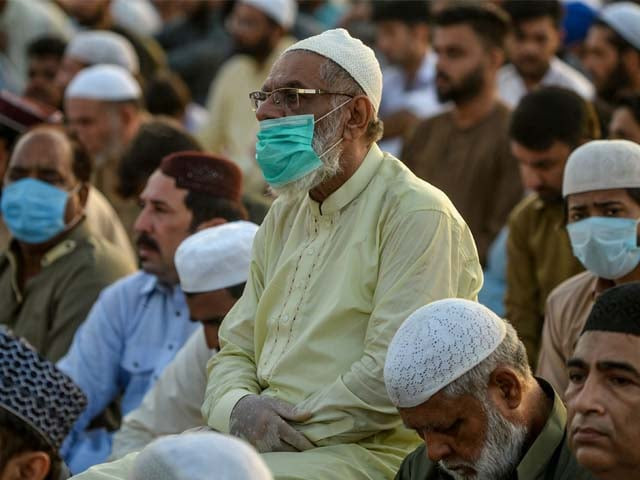After an alarming spike in June, the number of new Covid-19 cases in Pakistan has been steadily declining. Since peaking at over 6,000 in mid-June, the number of new confirmed cases has dropped to about a 1,000 a day now (Fig. 1). Similarly, since mid-June there has been a significant drop in the daily Covid-19 attributed deaths (Fig. 2). These developments were initially met with a healthy dose of skepticism with the critics of the government making pointed references to reduced testing and accusations of deliberate underreporting. Therefore, it is important to start by discussing the veracity of these trends.
 Fig. 1: Daily new confirmed Covid-19 cases in Pakistan
Fig. 1: Daily new confirmed Covid-19 cases in Pakistan
Fig. 2: Daily new confirmed Covid-19 deaths in Pakistan
Fig. 3 shows the total number of Covid-19 tests conducted every day in Pakistan. After peaking at just over 30,000 in mid-June the number is now recorded at about 22,000 tests a day. This reduction in the number of tests has often erroneously been labelled as the cause for the decreasing number of new Covid-19 cases in the country. As shown in Fig. 3, the number of daily tests has stabilised between 20,000 and 25,000 for most of July, while the number of new daily cases has nosedived from about 4,000 to about 1,000 over the same time period. This is also reflected in the steadily dropping positive test rate over the month of July (Fig. 4). For every one hundred tests conducted at the end of June, about fifteen were positive; this proportion has since dropped to just over five. Therefore, for the same number of tests conducted, fewer patients are testing positive now.
Fig. 3: Daily new Covid-19 tests in Pakistan
More importantly, the hard endpoints of number of patients ending up in high dependency units, on ventilators, or dead, have also trended in the right direction. In June, there were multiple reports of Pakistan’s fragile healthcare system being on the verge of collapse as hospitals across the country were overwhelmed with an unprecedented influx of patients. Recently however, hospitals across Pakistan are reporting an increasing number of vacant beds in their Covid19-designated high dependency and critical care units. It is important to remember that Pakistan’s healthcare infrastructure even at the best of times is inadequate for the country’s burgeoning population. It would not have taken a lot for this already fragile system to collapse, and no amount of the alleged underreporting by the government would have been able to cover up a complete breakdown of the country’s healthcare system. If the change in Pakistan’s Covid-19 trajectory between June and July had not been real, the country would by now be reminding the world of the horrific spectacles of makeshift morgues with inundated funeral service workers last seen in Italy, Ecuador and Spain.
Fig. 4: The share of daily Covid-19 tests that are positive in Pakistan (rolling 7-day average)
There are multiple reasons why it is important to highlight the thus far successful management of Covid-19 in Pakistan. Firstly, Pakistan’s healthcare workers – doctors, nurses, paramedics and pharmacists – have risked and lost their lives to contain the spread of Covid-19 in Pakistan. It is a result of their selfless efforts that despite limited resources the country has so far managed to avoid a public health catastrophe. Labelling the success of Pakistan’s Covid-19 response as a hoax is tantamount to ridiculing the sacrifices made by the country’s frontline healthcare workers.
Secondly, the turnaround has been the result of the government’s data-driven decision making led by the National Command and Operations Centre (NCOC). The incontrovertible bottom-line is that as of today Pakistan has contained the spread of Covid-19 to manageable levels. Pakistan has thus far succeeded where several other more developed countries have failed spectacularly, and it is a testament to the efforts of the country’s resource-deprived healthcare workforce as well as the timely, data-driven decision-making by the NCOC. While healthy criticism of the government is critical to the functioning of a vibrant democracy, it is also important to acknowledge the success stories in an unbiased manner.
None of this however should be cause for complacency. The dreadful June spike that brought the country’s healthcare system to the brink of a collapse was the result of the blatant disregard for precautions demonstrated at the time of Eid-ul-Fitr. Over the next month, between Eid-ul-Azha and Ashura, any callousness on the part of the government or the people, will undo all the gains made during the month of July. It can be reasonably posited that if the government fails to ensure adherence to SOP’s during Eid-al-Azha and Ashura, Pakistan could very well become the next global epicenter of Covid-19. On the other hand, if Pakistan can build on the gains of July over the next four weeks, the country could gradually reopen businesses and work towards a new normal where economic activity is steadily resumed while SOP’s are followed.
In summary after being at the brink of a public health catastrophe in June, Pakistan has made undeniable progress in its fight against Covid-19. The number of new Covid-19 cases, as well as the hard endpoints of Covid-19 mortality and the number of patients needing critical care have steadily trended down. While the turnaround is undoubtedly a result of the tireless efforts of the country’s healthcare workers as well as the prompt and clearheaded decision-making at the NCOC, Pakistan is not out of the woods by any means. In fact, Pakistan’s Covid-19 response stands at a critical crossroads; if the government can ensure adherence to SOP’s for the next four weeks there is a realistic possibility of resumption of economic activity in the country. In the event of recklessness during Eid-ul-Azha and Ashura however, Pakistan’s already overstrained healthcare system may not be able to withstand the impact of a second spike.
(*All the charts are downloaded from https://ourworldindata.org/ and are current as of July 30th, 2020.)





COMMENTS
Comments are moderated and generally will be posted if they are on-topic and not abusive.
For more information, please see our Comments FAQ